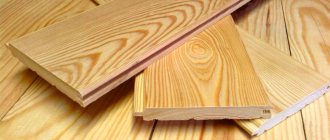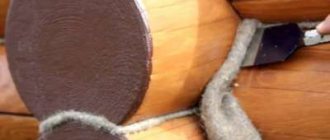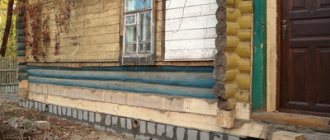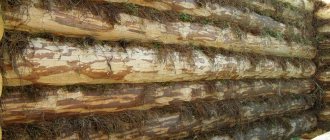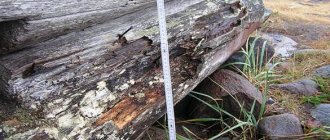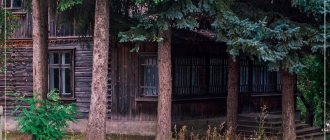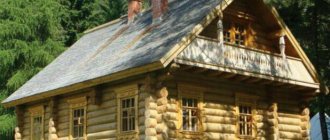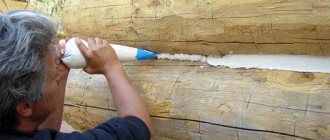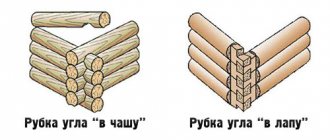The popularity of wooden houses is growing every year. This is primarily due to the demand for ecological housing. Wood is a material that goes well with the concept of a healthy lifestyle. In addition, wooden walls, according to many scientists, can have a healing effect. Everyone knows that in a wooden house you can breathe easier and sleep better.
If you decide to buy timber for building a house, then you must first of all choose a reliable supplier, since it is not so easy to find high-quality timber. The fact is that many manufacturers sell low-quality logs under the guise of high-quality ones.
To avoid mistakes and choose the right building materials for your future home, you need to understand important characteristics: the type of wood, when it was harvested, how it was stored, etc. We will tell you about this in this article.
Type of wood: summer or winter. Which one to choose for your future home?
The wood used to build a house and make a log house is divided into winter and summer.
Winter timber is timber that is harvested during the winter. According to its characteristics, it is more durable and this version of the raw material is of high quality.
But, when harvesting such timber, a rule must be observed: the timber must be aged. Those. For about a month after the trees are cut down, it should be kept in a well-ventilated warehouse. There is an important nuance here: if the tree is overexposed and left in a warehouse for six months or more, then it will not make a good log house.
In terms of its qualities, winter wood has many advantages for construction - it does not bend or shrink, like wood harvested in summer. Winter wood shrinks evenly during the drying process and, if the technology was followed correctly, then a log house made of such material will last at least 80-100 years. With proper care, a wooden house can last 200 years.
It should be noted that wood that is not completely dried causes cracks in the timber. Winter timber is considered the best in quality also because it has a reduced amount of sap; in winter, excess resin and insects come out of the tree.
Summer wood behaves completely differently . If the tree was cut down in the summer and harvested in the same season, then, with a high degree of probability, when installing the frame, some of the wood will crack. And this is due to the fact that uniform drying of the wood is almost impossible; one side of the timber will always be wetter than the other (for example, in places where the crowns touch each other).
Summer wood must be treated with a special compound that helps prevent mold from forming and decomposing. This composition prevents the penetration of insects and the development of fungus. Timber treated with this composition is certainly characterized by increased quality and durability.
Experts recommend that when choosing wood, already when inspecting the construction market, learn to distinguish high-quality material from low-grade material. So, an abundant number of cracks, knots, holes (often as a result of a knot falling out, in a place affected by a fungal infection), all such visible damage should alert you. Any deformation of the log can cause serious damage to the log house, so you should not buy such wood.
Two hundred and one defect
When choosing a log house, the main thing is to make sure that it is made of suitable material, because, of course, logs are different from logs. To begin with, you can arm yourself with knowledge about visible defects in logs, which number not even in tens, but in hundreds.
Even a seemingly ordinary knot (when a branch grows into the body of a log, and when cut, a characteristic round pattern is obtained) has 27 varieties. Visible wood defects are described in a separate document - an interstate standard, which is based on several GOSTs. This is a very fascinating read: in addition to 27 types of knots, here you can get acquainted with 17 types of cracks, 57 types of trunk defects, 5 types of chemical stains (including those resulting from drying), 23 types of fungal infections and rot, 11 types of biological damage (including wormholes and damage caused by birds), 34 types of mechanical damage to wood and 7 types of warping.
And then this interesting document describes in detail how all these defects are measured and how to properly classify them. There are also detailed drawings from which you can learn to distinguish wood defects. Separate chapters are devoted to round timber (this is what interests us when choosing a log house), veneer and lumber (these chapters will also definitely come in handy a little later, when you start finishing and deal with interfloor ceilings and other “wooden” construction work).
Photo: sekretymastera.ru
A humorous warning: if you are planning to build a wooden house, then you should read this standard in detail only if you have strong nerves - so that it doesn’t turn out like Jerome Klapka’s hero Jerome, who read a medical encyclopedia and, as a result, found everything described in it. diseases other than puerperal fever. However, it also contains reassuring information: not all types of visible wood defects affect its performance properties. Many of the two hundred defects described affect only the outside, in appearance.
Manufacturer or seller of logs. Who is better to buy from?
An important factor is who sells the log house to you. Just an intermediary or the manufacturer himself. In any case, you have the right to demand from the seller documents confirming the location of the log house production.
This information gives you a number of benefits. Firstly, you will know the origin of the wood , and secondly, you will be able to analyze the area and soil where the tree grew . The best location is considered to be forests on hills and hills, on dry soil. Wood grown in swampy areas and lowlands is more susceptible to rotting and fungal development.
Remember: healthy and dry wood is the best material . You should not be persuaded by sellers; you should check each log you buy yourself.
What is included in the log house kit?
Before purchasing a log house, it is better to immediately clarify what is included in the kit: lumber or just the log house . This is necessary to know, since very often sellers “inflate” the price.
Agree with the seller to make two calculations for you: one regarding only the log house, and the second with the log house and finishing materials. And even if the seller assures that finishing materials must be purchased together with the finished log house, do not be lazy and find out how much a set of lumber costs from a third-party seller. If you see a big difference, we recommend taking a log house without lumber and purchasing them separately.
Another difficult issue when purchasing a log house complete with lumber is quality. They can be made from low-quality raw materials: rotten or damp. After such a purchase, you will still have to buy wood of normal quality for interior finishing.
Marking - according to GOST
The main document that you should familiarize yourself with before choosing a log house today is GOST 2292-88 - “Round timber. Labeling, sorting, transportation, measurement methods and acceptance.” GOST 32594-2013, which describes measurement methods, is also useful (for example, there is an interesting table here that describes in detail how much wood in cubic meters is contained in lumber of a given thickness and length).
Photo: blog.marisrub.ru
Logs in a log house must be marked (each log, according to GOST, must be marked if the diameter of the log is more than 14 cm and the length is more than 2 meters). The marking is applied to the upper end of the log using a durable material (waterproof paint or special crayons). The main thing is that the label reaches the consumer in a legible state. The size of the marking should be at least 3-5 cm.
The marking must necessarily contain the following information: grade (from first to fourth, indicated by Roman or Arabic numerals) and thickness. Thickness is indicated in a more cunning way: in Arabic numerals, using the last digit of the thickness number:
- if the log thickness is 20, 30, 40, 50 cm and so on, the thickness marking will be 0;
- if the thickness is 22, 32, 42, 52, etc. — thickness is marked with the Arabic numeral 2;
- if the thickness is 14, 24, 34, etc. — GOST requires marking 4;
- Markings 6 and 8 are applied in similar cases.
GOST, which regulates the acceptance of lumber, describes the features of their acceptance. But in our case, if we choose a ready-made log house, its manufacturer is responsible for acceptance. However, it will also be useful for you to familiarize yourself with this section.
Inspection of the appearance of the log house
What to look for when buying a log house? Of course, you should examine the logs for chips, cracks, and dark spots . It is important that the wood has a smooth structure, without holes . If the one who sells you the product says that this is a feature of the tree, look for another seller. Good quality wood has a solid structure.
Quite often, buyers fall for such “persuasions” and buy a log house that has been eaten away by a bug, which undermines the wood fibers and will destroy the walls of the future home. Ideally, the material should be properly processed and stored under proper conditions. If the logs are eaten away by insects, this means that the wood was not stored indoors, but lay outdoors for at least two seasons, and sometimes three (summer, winter and spring).
Another common problem with improper storage of logs is the formation of mold and blue discoloration:
Whatever price the seller offers you, even if almost for nothing, you should not buy such logs, since it is no longer possible to fix it, and the structure of the wood has long been damaged.
Sound test of wood
To ensure the quality of the log, you need to “ring” . To do this, it is better to invite a second person to inspect the wood. And ask him to hit one end of the log with an ordinary metal spoon, and you, at the other end, should hear a sound.
If it is clearly heard, then this means that the wood is of good quality, and if the sound is not heard, then this means the wood is rotten. And the seller is trying to sell you a low-quality product for an excellent log house.
If you are considering purchasing wood, you should know that the most suitable trees for log houses in central Russia are: spruce, pine, larch. And all of them must clearly transmit sound or, as they say, “ring.”
How to determine the quality of logs using iodine (“green stuff”)?
Yes, this medical product is capable of showing a reaction by which one can judge the condition of the wood.
To see this reaction, it is necessary to apply iodine to the cut and the wood should turn purple . This occurs due to the accumulation of starch in winter material. If the tree turns brownish-yellow, this indicates that it was cut in the summer and was not dried enough.
If a log house is made from such logs, it will quickly become unusable, since it was initially poorly dried and the structure of the wood is too wet.
This method is also used to determine the season in which the material was manufactured. Therefore, even if the seller is trying to convince you that the wood was made in winter, do not be lazy to conduct this experiment: if the wood shows a different color than it should, you know that you are being deceived.
Profiled timber
An even more convenient material for construction. It also has four edges, two of which (top and bottom) are equipped with locking elements. These are recesses and protrusions made along the entire length of the beam. With their help, the parts are connected tightly (mortise-tenon connection), without gaps. No additional fasteners required.
Glued beam
The most modern material with particular strength. In this parameter, despite its wooden origin, it is even comparable to steel beams.
For the production of laminated veneer lumber, well-dried boards with a length of 12 meters, called lamellas, are used. They are often made composite, assembled end-to-end using glue from several elements. Their thickness ranges from 7.5 to 35 centimeters. The number of lamellas in a beam can be from two to eight. Most often there are three, four or five.
To make timber, the lamellas are treated with glue and placed under a press. Products are produced in square, rectangular, semicircular or round sections. Glued laminated timber can only be profiled. Its surface is well processed.
Walls made of this material are strong, even and smooth. With its help, due to the large length and special strength of the elements, it is possible to implement original projects. For example, build a house with huge windows or glazed walls, large spans, consoles. In such cases, there is no discussion about which timber is best for building a house. Naturally, they choose glued ones.
Glued beam
Checking the processing of logs
When inspecting a log house, special attention should be paid to the lower crowns. They must be treated with impregnations and special means that allow them to come into contact with moist soil and the foundation. You, as a buyer, have the right to know what antiseptics were used to treat the lower crowns. This information is very important if you are interested in ensuring that your future home lasts as long as possible.
It is also worth paying attention to how the logs were processed. This may be a method of debarking and planing.
When debarking, the bark is removed a little at a time. This method allows you to preserve the resin, which protects the tree from many adverse factors. Wood that is processed using the debarking method is more resistant to external influences and durable.
The second option is planing , in which the logs are planed using an electric planer. This process is slightly different from machine processing, but the surface of the log is smooth. A planer can injure a log and disrupt its structure, so processing in this way requires high professionalism.
If the logs are planed well enough, then they have very high reliability and are resistant to external adverse influences. Before such processing begins, the material is dried and debarked. This also helps to improve the quality of building materials and the strength of the future home.
Protection of log walls
They place a log bathhouse on (with a base half a meter high) or on screw piles.
To protect the logs from getting wet, the foundation is made ventilated - vents are installed on all sides (they are closed for the winter). They don’t skimp on roof overhangs. The larger the overhangs, the better. And the higher the bathhouse, the longer the overhangs will be required.
It is worth remembering that the distances between buildings are the distances between their projections on the ground.
Important! The minimum possible distances between buildings and trees are calculated by specialists and specified in regulations. Their compliance is checked by public services and local authorities
The aspect of fire safety has rightly received special attention. The most important thing is to maintain the distances between wooden structures (or if at least one of them is wooden).
There are distance standards that apply specifically to bathhouses, regardless of the material (for example, from a bathhouse to a poultry house). The maximum of all values must be observed.
A log bathhouse is treated with an antiseptic and fire retardant. The floor, the joists for its flooring, and the lower crown - under the floor - are especially carefully protected.
After using the bathhouse for its intended purpose, it is well ventilated.

